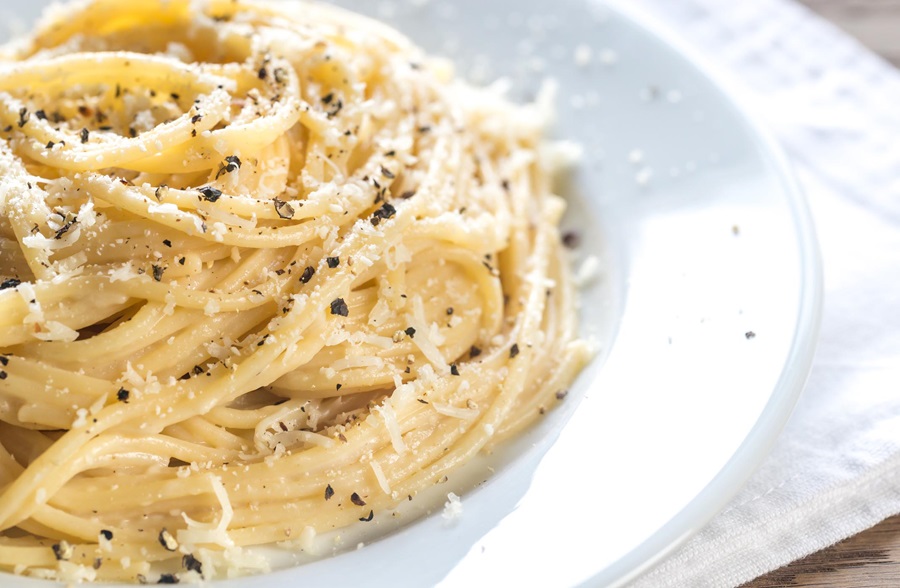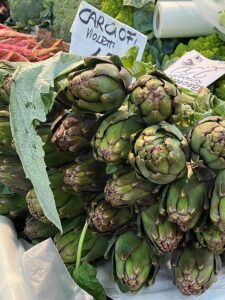I’ve long suspected that air travel is unnatural, and the physical effects of being hurtled through the air in a metal tube across several time zones get worse as I get older. But Christopher and I promised ourselves we’d go to Italy before the year was out.
We arrive exhausted and settle into Rome’s Prati neighborhood just outside the Aurelian Walls. While Christopher takes a nap, I head out in search of the restorative power of food. Aiming for the Mercato Trionfale, one of Rome’s largest public markets, I gain strength as I pass pizza stands and neighborhood trattorias where waiters carry out plates of Rome’s famously simple pasta dishes to sidewalk tables packed with afternoon diners. My recovery is aided by the aroma of cured pork cheek and black pepper wafting from plates of pasta all’ amatriciana and carbonara and alla gricia.
By the time I return to the hotel my hopes for dinner are set on something even simpler: cacio e pepe, just-done pasta coated in an alchemy of pecorino Romano cheese, olive oil, butter, and fresh pepper. The dish exemplifies the art of taking a few pantry ingredients and transforming them into gold.

We consult the hotel’s concierge about restaurants. She initially points us to Da Enzo in the Trastevere neighborhood. She also mentions that the line will be long. The spirit is willing, but the flesh says no way. Next, she suggests a place on the Via Guiseppe Avezzana, just a short walk from the hotel, named Cacio e Pepe. Inwardly I roll my eyes. I can’t formulate “absolutely not — that’s too gimmicky” in Italian, but the concierge seems secure in her recommendation, so we set off for dinner there.
On the way, Christopher reminds me, as he does when I get too focused on restaurant decisions, “This isn’t your last meal, it’s only your next one.”
Ten minutes later we’re seated at a little table covered with a white cloth. Next to us sits a beautiful Italian couple. He carries off a louche look as only Italian men can, his face stylishly scruffy and his tie carefully carelessly knotted. She might be a fashion model. They keep touching fingers and smiling and at some point he lights a cigarette and smokes in an unselfconscious way that no one in the U.S. has done for at least two decades. We’re glad this dream sequence is being played out at a sidewalk table.
While we have burrata and a plate of stuffed zucchini blossoms, they both order artichokes. He gets a soft braised one while hers is fried, flat and crisp in the style of Jewish Roman cooking. There’s always tomorrow night, we say to ourselves.

Soon enough, our waiter steers a kitchen cart toward our table. Perched on top is an enormous wheel of pecorino Romano, partially hollowed out. Into the hollow he pours steaming bucatini followed by a flurry of pepper from several grinds of a peppermill. As we and the impossibly stylish couple watch, he mixes the ingredients, using metal spoons to draw in cheese from the wheel. “Buon appetito,” he says, as he nestles a glistening serving of cacio e pepe on my plate. The dish gives off the strong floral smell of fresh black pepper, and the sauce is light and silky. The salty cheese and the pepper are perfectly balanced.
I realize that, romantic scrims aside, I am eating mac and cheese. But while really good American-style mac and cheese is actually not so easy to make, cacio e pepe is quick and simple, although technique is key to getting it right.
It’s important that the elements of the dish be combined in a receptacle other than the pot used to boil the pasta. That’s to keep excessive heat from causing the sauce to seize and become lumpy. I used to do the mixing in a warm bowl, which worked well enough. But then I read about the technique used by food writer J. Kenji Lopez-Alt. He warms a second skillet to “bloom” the pepper in oil as one would do with spices in Indian cooking and then does the final mixing in the partially cooled pan. The technique brings out the floral notes in the pepper.
Also, pasta water is your friend. It is crucial to coaxing creaminess out of dry, aged cheese. Despite what you’ve been taught, it’s best to cook the pasta in a little water rather than a lot. This leaves the water with more concentrated starches and so adds creaminess to the sauce. I’ve taken to cooking mine in a wide skillet with just enough water to cover the strands.
Grate your cheese as fine as possible — the cheese will melt faster and more uniformly that way. Using a microplane grater is ideal. And finally, fresh black peppercorns, coarsely ground, are absolutely crucial to the perfect cacio e pepe.
As I settled into my plate of pasta, I let go of my doubts about flying and worries about right restaurant choices. Here I was with Christopher on a warm autumn night in the Eternal City eating the dish I’d been waiting for all summer long.
Bucatini Cacio e Pepe
Makes 4 servings
Bucatini looks like a thick spaghetti; it’s extruded with a hole in the center, like a drinking straw. It is used in buttery sauces and is a classic paired with cacio e pepe, but using spaghetti is just fine, too.
8 Tbsp. extra-virgin olive oil, divided
2 tsp. freshly ground black pepper
Kosher salt to taste
1 lb. high quality bucatini or spaghetti
4 Tbsp. unsalted butter
4 oz. pecorino Romano cheese (about 2 cups), very finely grated on a microplane or the smallest holes of a box grater, plus more for serving
- Heat 6 tablespoons olive oil and the black pepper in a medium skillet over medium-low heat until the pepper is fragrant and just starting to sizzle, about 1 minute. Set aside to allow the pan to cool somewhat.
- Place the pasta in a large, deep skillet and cover with water. Season with a generous pinch of salt (do not oversalt as you will be using the water as an element of the sauce), then bring to a boil over high heat, moving the spaghetti around occasionally with a fork to keep it from clumping. Cook until it’s al dente, about a minute less than the package recommends. Do not drain the pasta. Transfer 2 to 3 tablespoons of the pasta cooking water to the skillet with the pepper. Stir in the butter. Using tongs, lift the pasta from the water and transfer it to the oil and butter mixture (reserve the rest of the pasta water in case it’s needed).
- Add cheese and remaining olive oil to the pasta and stir with two forks until cheese is completely melted. Add a few more tablespoons of pasta water to the skillet to adjust consistency of the sauce if needed. The sauce should be creamy and coat each strand of pasta more or less evenly. Season to taste with salt and more black pepper.
- Serve immediately (if needed, once the sauce is emulsified, you may gently reheat the dish). Pass extra grated cheese and black pepper at the table.



